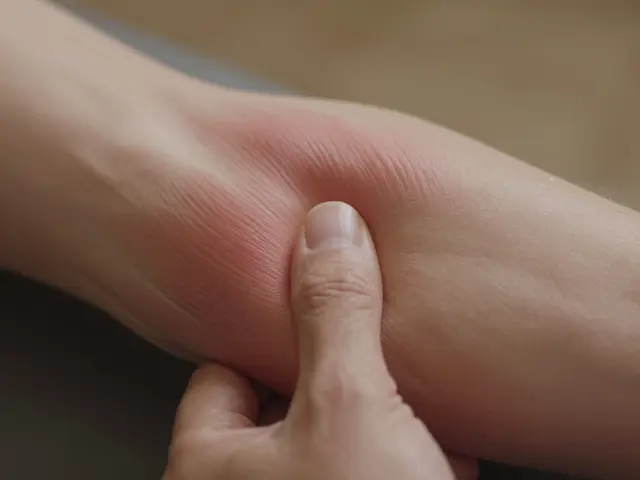Breema Bodywork: Exploring Holistic Healing and Energy Balance

Breema stands out in the vast landscape of holistic health practices for its unique approach to achieving wellness through harmony and balance. Often referred to as 'the art of being present,' Breema focuses on integrating body, mind, and emotions to promote overall well-being. This introduction sets the stage for a deeper exploration of what Breema is, its foundational principles, and the techniques involved. Additionally, we'll look at the numerous health benefits linked to regular Breema practice and offer practical advice on how to weave these practices into the fabric of daily life.
- What is Breema?
- Core Principles of Breema
- Techniques and Practices
- Health Benefits of Breema
- Incorporating Breema into Everyday Life
What is Breema?
Breema bodywork, often described as a nurturing dance, originates from a traditional form of holistic healing. Unlike more widely recognized techniques such as Reiki or acupuncture which often focus on the manipulation of energy directly, Breema emphasizes the art of being present and the experience of body and mind coming together. This healing practice centers on self-understanding and the nurturing of vitality through gentle stretches, rhythmic movements, and precise postures. It is characterized by a profound respect for the body’s wisdom and an emphasis on nurturing, rather than merely fixing or altering physical states.
The philosophy behind Breema is rooted in the Nine Principles of Harmony: Body Comfortable, No Extra, Firmness and Gentleness, Full Participation, Mutual Support, No Judgment, Single Moment/Single Activity, No Hurry/No Pause, and No Force. These guiding principles inform every movement and interaction, aiming to foster presence and mindfulness both for the practitioner and the recipient. The idea is not just to relax or provide temporary relief, but to create a transformative experience that heightens personal awareness and harmony.
Proponents of Breema assert that this practice aids in reducing stress, enhancing energy, and promoting an overall sense of connectivity with one’s environment. Practitioners often report a deep sense of peace and connectedness during and after sessions. This feeling of unity and peace is not just anecdotal; it reflects the very essence of Breema’s holistic approach, which aims to support both physical health and emotional resilience. This supports a lifestyle that is more responsive and less reactive, a crucial factor in maintaining overall well-being in our fast-paced world.
Core Principles of Breema
The essence of Breema is often captured through its core principles, which serve as the foundational stones for its practice and philosophy. Among these, the principle of Body Comfortable underlines the idea that for any healing or growth to occur, the body must be free from stress and discomfort. This aligns closely with the principle of No Extra, which teaches the minimization of unnecessary force in movements, encouraging efficiency and ease.
Another vital component is the principle of Full Participation, where the practitioner and recipient are both fully present in the moment. This is complemented by the principle of Mutual Support, fostering a give-and-take relationship that benefits both parties emotionally and energetically. The principle of No Judgment frees individuals from the constraints of criticism and comparison, facilitating a more accepting and compassionate approach to self-awareness and healing.
The practice of Single Moment/Single Activity emphasizes the importance of focusing completely on the task at hand, without distraction. This is encapsulated in the Breema saying, 'The aim is to be present.' The principle of Non-Force teaches that true power comes not through force, but through a clear, direct, and precise response. This principle helps in maintaining energy levels and preventing burnout.
The Nine Principles of Harmony are collectively designed to create an atmosphere where the body can find its natural balance and self-healing properties. These principles are not just theoretical; they are meant to be lived and experienced. Practitioners often find that applying these principles not only improves their practice of Breema but also enhances their daily life, promoting a peaceful and balanced existence.
Indeed, one practitioner in her reflection noted,
'Applying Breema's principles has subtly shifted my approach to life. I find a profound sense of connection and calmness pervading my daily activities.'
Techniques and Practices
The essence of Breema lies in its approach to creating a natural flow of physical movements and mental attentiveness, which ultimately aims at enhancing the connection between the body and the mind. There are several key techniques used in Breema, each with specific steps and purposes, designed to increase body awareness and energize the entire being. One of the fundamental techniques is the bodywork itself, where the practitioner uses gentle stretches, rhythmic movements, and firm but comforting holds. This method not only aids in the relaxation of muscles but also enhances mental clarity and emotional balance.
Another pivotal practice within Breema is the principle of 'No Judgment'—a mindset that encourages practitioners and recipients alike to engage in sessions without preconceptions or the imposition of subjective assessments. This facilitates a unique kind of presence and attentiveness that is rare in other healing practices. Through exercises such as the Breema body sweep or the lean and pull method, participants experience a deep form of relaxation that often leads to personal insights and heightened self-awareness.
Self-Breema exercises are also integral to this practice. They consist of simple, structured movements that can be performed alone, focusing on self-healing and personal energy renewal. These exercises encourage grounding, balance, and mental clarity, making them a suitable practice for anyone, regardless of their physical condition or age. The integration of these movements into daily routines is an empowering method of maintaining connection and harmony within oneself.
During Breema sessions, the emphasis is always placed on the 'art of touch'. Touch, in this context, is not just a physical interaction but also a communication tool that conveys support and nurturance without the need for words. It's a powerful aspect of Breema that helps in establishing trust and connectivity between the practitioner and the recipient. This unique interaction aids in the dissolution of stress barriers and the enhancement of positive energies.
Moreover, the philosophy and practice of Breema do not stop at the physical or even mental level. They extend into a comprehensive lifestyle approach that encourages continuous personal growth and wellness enhancement. Practitioners often report major transformations that are not just limited to physical wellness but also extend into their emotional and psychological realms, impacting their relationships and outlook on life.
Health Benefits of Breema
The impact of Breema on an individual's health cannot be overstated. By harmonizing body, mind, and emotions through gentle movements and stretches, this therapy enhances physical and mental vitality. Many who practice Breema report a notable decrease in stress and anxiety, which is a direct effect of the practice's grounding techniques. Stress reduction is crucial for maintaining overall well-being and can significantly lower the risk of many chronic diseases.
Another significant benefit is the improvement in flexibility and balance. Breema exercises are designed not only to relax tense muscles but also to promote smoother and more balanced physical movements. Over time, individuals may notice less stiffness and an improvement in their range of motion, which can be particularly beneficial as one ages. This aspect of Breema is especially important for those who might feel limited by physical conditions or older adults who are managing age-related physiological changes.
One of the striking impacts of Breema is its role in enhancing sleep quality. Consistent practice helps in regulating sleep patterns, leading to deeper and more restful nights. This is critical, as quality sleep is linked to better mental and emotional health, sharper cognition, and greater energy levels during the day. Improved sleep can translate to numerous health benefits, including better mood regulation and a stronger immune system.
Emotionally, Breema is a powerful tool for enhancing emotional resilience and stability. The techniques encourage presence and mindfulness, helping practitioners experience the moment without the clutter of past regrets or future anxieties. This psychological benefit is profound as it contributes to a healthier, more optimistic outlook on life, fostering an environment where stress is less likely to take hold.
For those seeking a holistic approach to health that encompasses physical, mental, and emotional improvement, Breema offers a comprehensive solution. Through its gentle, accessible movements and the philosophical teachings that accompany the physical practices, Breema supports sustained well-being and vitality, proving to be a health practice that touches every aspect of human life.
Incorporating Breema into Everyday Life
Integrating the principles and practices of Breema into everyday life can transform routine activities into moments of deep awareness and connection. The essence of Breema is to be present in what you are doing at every moment. This mindfulness enriches even the simplest tasks, from brushing your teeth to answering emails. One begins by attending to the body's movements and the sensations associated with them. For instance, while walking, one might focus on the feel of each foot as it touches the ground, fully engaging with the experience rather than letting the mind wander to concerns of past or future.
Another way to bring Breema's soothing essence into daily life is through 'Self-Breema exercises.' These are simple movements performed to establish a harmony between mind, body, and feelings. Practicing these exercises daily can significantly enhance mental clarity and emotional balance. For example, a simple exercise involves gently holding each finger for a few moments, which can help center and calm the mind. This practice doesn't require any special equipment and can be done anywhere, emphasizing energy balance throughout the day.
At the workplace, Breema principles can reduce stress and improve interpersonal relationships. It teaches us to approach our work tasks with full participation and presence, which not only boosts productivity but also enhances creativity. Encouraging a brief Breema session during breaks can lead to a more harmonious work environment as it relieves physical and mental tension. Imagine engaging in a few stretches or body movements at your desk, subtly but effectively shifting your energy and focus.
Food and eating habits are also an integral aspect where Breema can have a notable impact. It promotes eating with awareness and thankfulness, turning a routine meal into a nourishing experience for the body and soul. Paying attention to the tastes, textures, and the act of eating slowly can transform the relationship one has with food. This mindful eating aligns with Breema's philosophy of presence and simplicity, bringing one closer to a balanced state of being.
In the social sphere, applying Breema principles means interacting with others with a genuine sense of connection and presence. This could mean being fully attentive when someone is speaking, rather than planning what to say next. This approach strengthens relationships and fosters a deeper understanding and respect among individuals. As connections deepen, social interactions become more meaningful, and mutual support strengthens within the community.





